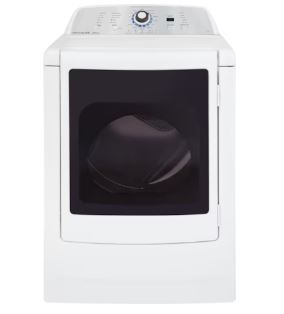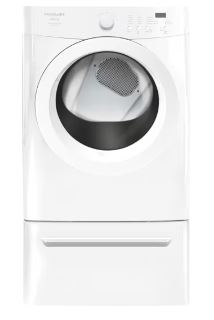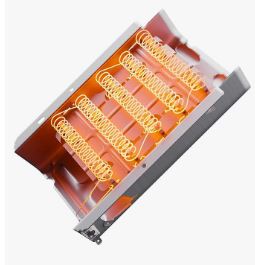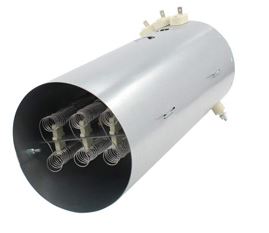The heating element is essential to your Frigidaire Affinity dryer’s heating and drying functions. Its failure means your dryer won’t do its job of drying clothes, and that’s where a Frigidaire Affinity dryer heating element replacement is necessary.
Replacing the heating element on a Frigidaire affinity dryer involves five quick steps: disconnect the dryer’s power supply, disassemble the dryer, detach the old heating element and attach its replacement, and reassemble the dryer.
I’ll walk you through all those five steps to enable you to replace the heating element DIY. If you can do that, you will save money and time as you’ll get your dryer back heating and drying your clothes as soon as possible.
In addition to discussing how you can replace your dryer’s heating element, we shall look at how the heating element fails in the first place, the signs to indicate it’s faulty, and how you can check it. But first, let me help you understand the role of the heating element in your dryer.

Role of the Heating Element in a Frigidaire Affinity Dryer
If you have an electric Frigidaire Affinity dryer, it depends on the heating element to get hot and dry the wet laundry. The heating element generally generates heat for the dryer, which is essential for vaporizing moisture from wet clothes.
The heating element is strategically positioned behind the rear access or at the bottom of your dryer. It automatically activates when you power on and run the dryer. Without it, the dryer won’t get hot and won’t dry your clothes.
Signs of a Faulty Frigidaire Affinity Dryer Heating Element
You can tell that your Frigidaire Affinity dryer heating element is defective by observing these signs:
- Non-heating dryer – The heating element is likely faulty if your Frigidaire Affinity dryer runs but doesn’t produce heat. It could be burnt out or damaged and thus can’t produce heat.
- Incomplete drying – If your Frigidaire Affinity dryer takes an unusually long to get hot or the clothes come out soaking wet after the end of the drying cycle, the heating element is likely defective.
- Visible damage – The heating element won’t work if damaged. You can tell if that’s the case by taking out the rear access panel and visually observing it. Check for breaks, wear, and other signs of physical damage.
- Inconsistent temperature – If your dryer’s temperature suddenly drops or spikes and repetitively does that, the chances are that the heating element is defective. It means the heating element fails to regulate the dryer’s temperature correctly.
- Inaccurate thermostat reading – If the thermostat doesn’t read the dryer’s temperature correctly, it could be due to a malfunctioning heating element.
- Unusual noise – While this doesn’t directly point to a defective heating element, an unusual noise during a running cycle could suggest a struggling heating element. It could indicate that the heating element is struggling to keep up with the heat demands of the dryer.
- Burning smell – Sometimes, a short-circuited heating element produces a burning smell. At other times, the burning smell could result from an overheating dryer, which can overheat due to a defective heating element, among many different reasons.
How Does the Heating Element Fail in a Frigidaire Affinity Dryer?
The heating element of your Frigidaire affinity dryer may fail due to different reasons, and the most notable ones are:
- Natural wear – The dryer and every other component, including the heating element, may wear over time. When it does, it’s unable to work correctly. Of course, this depends on the level of maintenance, as the more you look after the dryer, the likelier it is to serve you.
- Mechanical damage – The heating element may suffer physical damage if you place extra weight on the dryer and damage it.
- Short-circuiting – Electrical issues like power surges or spikes and faulty wiring can cause the heating element to short-circuit. Once that happens, the heating element will fail.
- Overheating dryer – Due to restricted airflow, perhaps from an obstructed dryer vent, the dryer may overheat and burn out the heating element. Once burnt, the heating element becomes defective, necessitating a replacement.
- Rusting – If there are signs of rust around the heating element coils, they could cause the heating element to fail. That happens when moisture gets to the heating element, especially the coils, and encourages corrosion.
- Manufacturing defects – Though rare, the manufacturer sometimes makes mistakes and produces a poorly assembled heating element. Once that’s the case, you cannot expect the heating element to heat the dryer.
- Inaccurate thermostat reading – If the thermostat fails to regulate the dryer temperature, the dryer may overheat and burn up the heating element.

How to Check for a Faulty Frigidaire Affinity Dryer Heating Element
There are four ways to tell if the Frigidaire Affinity dryer is really faulty, and they include the following:
1. Visual Inspection
You can tell if the heating element is defective if you observe signs of damage (breaks, wear, and tear), rust, and burns. However, to do the visual inspection, disconnect the dryer and take down the rear access panel. That allows you to view and scrutinize the heating element for damage effects.
2. Continuity Test
Using a multimeter, you can tell if the heating element in your Affinity dryer is defective.
Here’s how to go about it:
- Set the multimeter on continuity or resistance setting
- Disconnect the heating element’s wiring
- Probe the multimeter into the heating element’s contact points
- Check the display to see if there’s any continuity or a low resistance reading
- A low resistance reading or lack of continuity confirms a defective heating element
3. Voltage Testing
You can also use the multimeter to check if your dryer heating element has the required voltage. Typically, the standard voltage requirement for most dryers, including Frigidaire dryers, is 240 volts. However, you should confirm this with your dryer manual.
4. Defective Thermal Fuse
You can also tell a defective heating element from an equally bad thermal fuse. In most cases, a faulty thermal fuse causes the heating element to fail as it’s unable to protect it from overheating and short-circuiting during a power spike.
But How Do You Change a Heating Element in A Frigidaire Affinity Dryer?
Now that you know how to check for a defective heating element, let’s discuss its replacement.
Supplies
- New heating element – Check the Frigidaire Affinity Dryer Heating Element Part Number to ensure it matches the existing
- Nose pliers
- Screwdrivers (flathead & Philips)
- Multimeter
- Work gloves
- Camera (phone camera will do) or paper and pen
- Socket wrench

Frigidaire Affinity Dryer Heating Element Replacement Steps
Now, here’s how to replace Frigidaire Affinity dryer heating element:
Step 1 – Disconnect the dryer’s power supply
Safety first;
Put on the work gloves and plug out the dryer. You can also flip its circuit breaker off to avoid any risk of electrocution.
Step 2 – Disassemble the dryer
Use the screwdriver to unscrew the rear panel and set it aside. That allows you to access the heating element.
Step 3 – Detach the old heating element
Use the nose pliers to remove any wiring harness on the old heating element. Then unscrew any screws holding the heating element before gently sliding it out of the housing.
Remember to note down or take photos of the heating element in its position before removing it for easy installation. Also, observe the old heating element for faultiness or test it with a multimeter, as shared earlier, to affirm its defectiveness.
Step 4 – Attach the replacement heating element
If the old heating element proves defective, you don’t have to return it. Instead, you should reinstall the new heating element and ensure you reconnect the detached wiring harness just as everything was initially. You can refer to the notes or photos you took.
Step 5 – Reassemble the dryer
Once the replacement heating element is in place, return the rear access panel and screw it back tightly. Then plug back the dryer and power it on.
Note
You can test-run the dryer to see if it’s working. It should be able to heat up. If it doesn’t, it could be a different issue, not the heating element; hence, you should call a dryer expert.

People Also Ask
1. Why Is My Frigidaire Affinity Dryer Not Heating?
Your Frigidaire affinity dryer might not be heating up due to the lack of or inadequate power supply, wrong ‘non-heat’ setting or cycle, or failed gas supply (if it’s gas-powered). It could also be due to a defective heating element, thermostat, thermal fuse, timer, or control board. Don’t forget to check for a lint-obstructed dryer vent or lint filter.
2. Where Is the Heating Element On My Frigidaire Affinity Dryer?
The Frigidaire Affinity dryer heating element location is mainly beneath the rear access panel. It must be at the bottom of the dryer if it’s not there. You must remove the back access panel to locate the heating element.
3. Should I Replace the Heating Element in A Dryer?
The decision to replace your dryer’s heating element depends on several factors, such as the dryer’s condition, age, cost, and warranty. If the dryer suffers frequent mechanical failures or is too old, replacing it won’t be worth it. However, if it’s new and rarely breaks down, a heating element replacement may be worth it.
As for the cost, it’s only worth replacing the heating element if the replacement cost isn’t similar or close to replacing the dryer. Moreover, replacing the heating may not be worth it if the dryer is still under warranty, as such an action could void the warranty.
4. How Do I Reset My Frigidaire Affinity Dryer?
You can reset your Frigidaire Affinity dryer by pressing the power button, plugging out the dryer for 5-10 minutes, or flipping off the circuit breaker for 5-10 minutes. Check the manual for other reset ideas if the dryer doesn’t reset.
Concluding Thought On Frigidaire Affinity Dryer Heating Element Replacement:
As shared, replacing the heating element on your Frigidaire Affinity dryer only takes five steps. That involves disconnecting and disassembling the dryer, removing the old heating element, installing its replacement, and reassembling the dryer.
Remember, however, to test the heating element, probably with a multimeter or visually examine it to determine if it’s faulty before replacing it, as that could be expensive and time-consuming.
